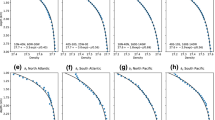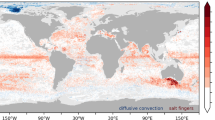Abstract
Almost half of the oceanic water columns exhibit double-diffusion. The importance of double-diffusion in global oceans’ salt and heat fluxes, water-mass formation and mixing, and circulation is increasingly recognized. However, such an important physical process in the ocean has not been well studied. One of the reasons is the difficulty of parameterizing and quantifying the processes. The paper presented here attempts to quantify the double-diffusive fluxes of salt and heat in the ocean. Previous qualitative analysis by applying the water-mass Turner angle, mTu, to the North Pacific Intermediate Water (NPIW) layer showed a favorable condition for salt-fingering in the upper NPIW due to the overlying warm/salty water above the cold/fresh NPIW core, and a doubly-stable condition in the lower NPIW where potential temperature decreases with depth while salinity increases, inducing double stratification with respect to both potential temperature and salinity. The present study gives a quantitative estimate of double-diffusive fluxes of salt and heat contributed by salt-fingering in the upper NPIW layer.
Similar content being viewed by others
References
Gargett, A.E., and G. Holloway, 1992. Sensitivity of the GFDL ocean model to different diffusivities for heat and salt. J. Phys. Oceanogr., 22: 1158–1177.
Levitus, S., 1994. World Ocean Atlas 1994 [CD-ROM]. Informal Report 13. Ocean Climate Laboratory, National Oceanographic Data Center, Silver Spring, M.D. USA.
Lozier, M.S., M.S. McCartney, and W.B. Owens, 1994. Anomalous anomalies in averaged hydrographic data. J. Phys. Oceanogr., 24: 2624–2638.
Macdonald, A.M., T. Suga, and R. G. Curry, 2001. An isopycnally averaged North Pacific climatology. J. Atmos. and Oceanic Tech., 18: 394–420.
McDougall, T.J., S.A. Thorpe, and C.H. Gibson, 1988. Small-scale turbulence and mixing in the ocean. In: Small-scale Turbulence and Mixing in the Ocean. J. C. J. Nihoul, and B. M. Jamart, eds. Elsevier, Amsterdam, pp. 3–9.
McDougall, T.J., and B.R. Ruddick, 1992. The use of ocean microstructure to quantify both turbulent mixing and salt-fingering. Deep-Sea Res. I, 39: 1931–1952.
Ruddick, B.R., 1983. A practical indicator of the stability of the water column to double-diffusive activity. Deep-Sea Res., 30: 1105–1107.
Schmitt, R.W., 1981. Form of the temperature-salinity relationship in the central water: evidence for double-diffusive mixing. J. Phys. Oceanogr., 11: 1015–1026.
Schmitt, R. W., 1994. Double-diffusion in oceanography. Ann. Rev. Fluid Mech., 26: 255–285.
Stern, M. E., 1960. The ‘salt-fountain’ and thermohaline convection. Tellus, 12: 172–175.
Turner, J.S., and H. Stommel, 1964. A new case of convection in the presence of combined vertical salinity and temperature gradients. Proc. Nat. Acad. Sci., 52: 49–53.
You, Y., 1996. Dianeutral mixing in the thermocline of the Indian Ocean. Deep-Sea Res. I, 43: 291–320.
You, Y., 1998. Dianeutral mixing and transformation of Antarctic Intermediate Water in the Indian Ocean, J. Geophys. Res., 103: 30941–30971.
You, Y., 1999. Dianeutral mixing, transformation and transport of the deep water of the Indian Ocean. Deep-Sea Res. I, 46: 109–148.
You, Y., 2000. Contribution of salt-fingering to the conveyor belt circulation in the abyssal northern Indian Ocean. Geophys. Res. Lett., 27: 3913–3916.
You, Y., 2002. A global ocean climatological atlas of the Turner angle: implications for double-diffusion and water-mass structure. Deep-Sea Res. I, 49: 2075–2093.
You, Y., 2003 a. Implications of cabbeling on the formation and transformation mechanism of North Pacific Intermediate Water. J. Geophys. Res., 108: 3134, doi: 10. 1029/2001JC001285.
You, Y., 2003 b. The pathway, and circulation of North Pacific Intermediate Water. Geophys. Res. Lett., 30: doi: 10.1029/2003GL018561.
You, Y., N. Suginohara, M. Fukasawa, I. Yasuda, I. Kaneko, et al., 2000. Roles of the Okhotsk Sea and Gulf of Alaska in forming the North Pacific Intermediate Water. J. Geophys. Res., 105: 3253–3280.
Zhang, J., R.W. Schmitt, and R.X. Huang, 1998. Sensitivity of the GFDL modular ocean model to parameterization of double-diffusive processes. J. Phys. Oceanogr., 28: 589–605.
Author information
Authors and Affiliations
Rights and permissions
About this article
Cite this article
You, Y. Double-diffusive fluxes of salt and heat in the upper layer of north pacific intermediate water. J Ocean Univ. China 4, 1–7 (2005). https://doi.org/10.1007/s11802-005-0016-4
Received:
Accepted:
Issue Date:
DOI: https://doi.org/10.1007/s11802-005-0016-4




